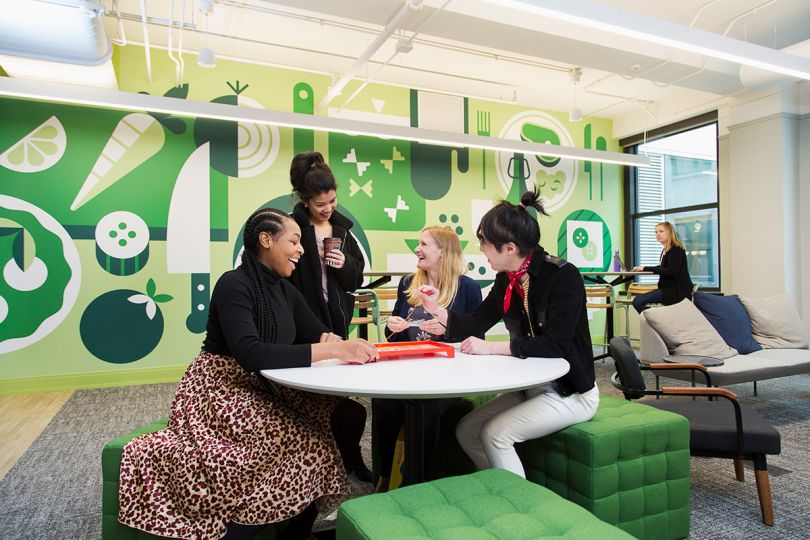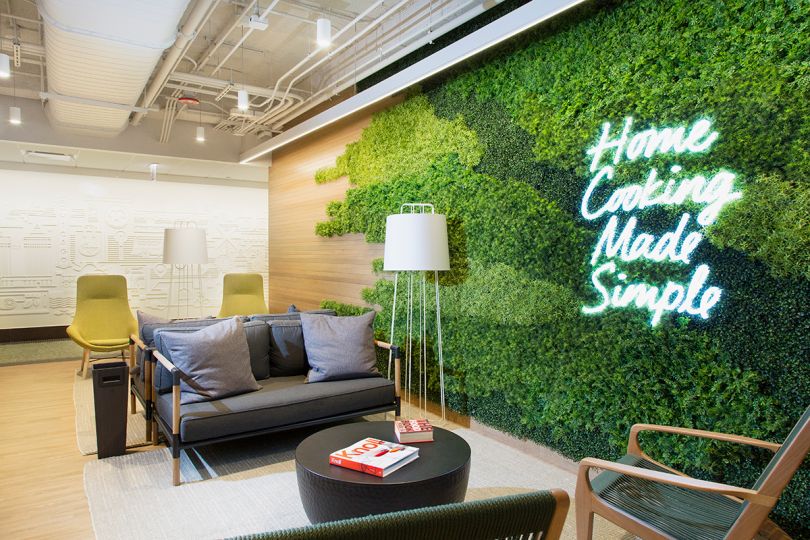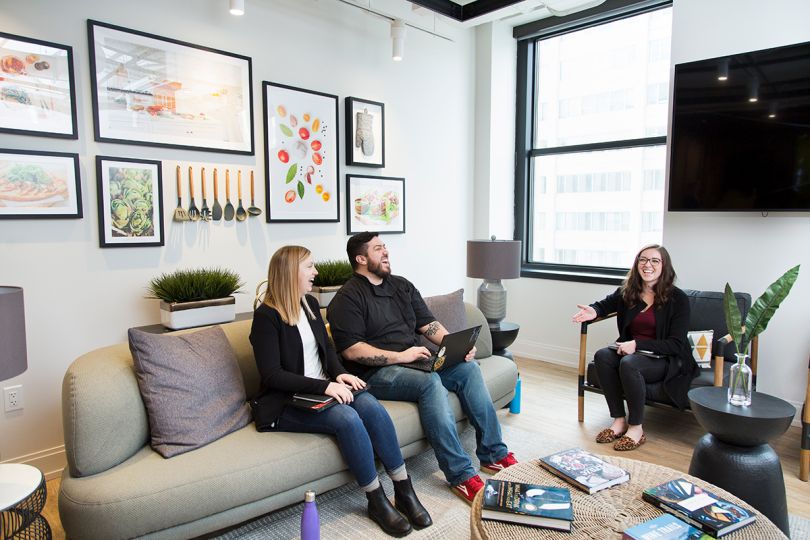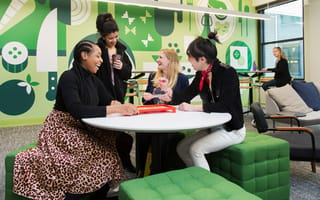When Veronica Vyas was asked to look for a child care benefit for the team at Home Chef, the senior benefits manager couldn’t believe her boss was serious. “I’ve never been with a company that’s offered that as a benefit,” she explained. “But because the turnover in our hourly workforce last year was due, in part, to lack of child care, we decided to roll out this program to help with the situation.”
That wasn’t the only improvement the meal kit and food delivery company’s leadership knew they needed to make in order to foster a culture of belonging and support. As director of human resources and diversity, equity and inclusion, Jasmine Primm sought to bridge the language-based communication gap employees were experiencing at their plant locations: “For me and Veronica, identifying as minorities, it’s important to us that employees can be their authentic selves in the workplace.”
The partnership between Home Chef’s HR and operations teams led to the introduction of Langogo translation devices at their plants — and it’s just one of many projects they intend to work on together. In the coming year, Primm looks forward to aligning both her HR and DEI practices with Vyas’ operations in order to “create equity within benefits.”
“Our human resources and operations teams have committed to working closer together this year because our work overlaps and impacts people throughout the company,” said Primm. In order to find common ground, their teams have united to not only develop new benefits, but to do it with speed and grace.
In reality, what’s on the table in terms of benefits is a constantly-changing landscape that Primm, Vyas and their respective teams are tapping into to better reflect the needs of both hourly and salaried Home Chef associates — whether that’s through 401(k) matching or education options.
For Vyas in particular, the exploration element of her role is part of the fun of working at Home Chef. “This is one of the few companies I’ve worked at where the employee is put first, and I absolutely love it,” said Vyas. “The culture is very, very different — it’s all about the employee.”

When did it become clear that it was important to refocus on employees as people, rather than just employees?
Primm: Human resources is really foundational; we touch every single part of the company. The culture shift happened as our team became very well staffed and acclimated. We work a lot closer together now than we did two years ago because we’re less siloed, and we work cross-functionally with all of our teams. Latasha Kempadoo is our first chief people officer, and this is the first time we’ve truly had someone champion human resources and the importance of what that means in the workplace. Her leadership and willingness to always push the envelope has encouraged all of us to do the same.
We’re trying to show employees that we care in different areas.”
The biggest thing we’re hoping to address is retention; we want Home Chef to be a great place for everyone to work — not just for our salaried teams or for one specific location. We want culture to take on a life of its own at each of our facilities. Because each facility’s leader is different, we want to know we’re all looking through the same lens to allow that culture to take on its own meaning. We’re constantly evaluating how and what we spend to grow and develop our people to retain them for longer. What can we continue to add that would make this a great place to work? Will tuition reimbursement, English as a second language classes, or continuing education and growth within functions allow us to promote more people internally? The better and more efficiently we spend our dollars, the more programs we can implement.
What makes your company culture stand out from its competitors?
Primm: We don’t say anything that we don’t do. The things we do say, we really deliver on — and we do them well. The speed at which we can do things and course correct is something that stands out. For example, when I worked at a big-box company, it took me three and a half years to partner with benefits and successfully implement a child care program. To be able to do it for Home Chef in six to eight months was beautiful. It’s something that affected our teams right away.
We’re very nimble in being able to meet people halfway. If you ask for what you need to feel supported and valued, very rarely is it a “no.” It’s usually a “we might not be able to do that, but we can do this.” And if it is “no,” we truly take it to heart and continue evaluating whether or not it’s a trend across a larger employee group that needs to be addressed and prioritized in the future.

Where are you expanding benefits, and what role has the pandemic played in the to offer them?
Vyas: During open enrollment, I went on a roadshow to our plants. I spoke directly with hourly employees and made a point to explain how the benefits work and answer questions. If they needed guidance with enrolling, I was there to help them. For the corporate salaried employees, we did Zoom meetings since they have a better understanding of how our benefits work. We not only rolled out a program for hourly employees this year that gives them 10 backup child care days, but in February, we created a new employee assistance program with SupportLinc. We’re also looking into a gym membership program and plan to do wellness fairs and a 401(k) education roadshow this year.
Due to the pandemic, there’s been a lot of demand for counseling, so we’re bringing a counselor on-site to all three of our plants. And the tuition reimbursement program, which we’re in the final stages of, is going to be great. We’re trying to show employees that we care in different areas.
In a word, how would you describe Home Chef’s company culture?
- “Collaborative.” — Vyas
- “Evolving. As the business changes, our culture remains focused, but evolves to better support our people and the business.” — Primm
Veronica, tell us about the work you’ve done with Care.com. Why was the decision to offer child care services important?
Vyas: It was a fascinating experience. Based on benchmark data, the 10 days we’re giving our employees is more than other employers give. And Care.com is a leader in the caregiving industry. They have a great platform — accessible through their app, over the phone or online — which makes it very easy for employees to access and reserve caregivers.
Last year, our exit surveys revealed that when employees decided to leave the company, it was due to child care issues. That turnover is what led us to start looking into care services for our employees at the plant level. Once we start going back into the office, we will roll it out to salaried employees as well; hopefully next year.
Are there any other programs or benefits you’ve offered that are really striking a chord with employees?
Vyas: We recently rolled out on-site counseling at our Bedford Park, Illinois, location, and that’s been a really big hit. At that specific plant, we have a large Spanish-speaking population, and the counselor there is bilingual. Once we have counselors at our other two plants, we hope our employees take advantage of that on-site benefit as well. As of January 1st, we rolled out a brand-new safe harbor plan for our 401(k). Our employer match is more robust, so it’s more appealing to new hires.
Primm: Despite all of these new programs rolling out, Veronica and I are constantly working together to scope how we can give back to our people and the communities we work in. We’re looking at a lot of different resources, from tuition to figuring out how to work closer with communities from a corporate social responsibility standpoint. Knowing the demographic of our hourly employees, we also wanted to offer a transportation benefit. While not everyone uses it, it does come in handy for a lot of our employees. I’ve gotten feedback from several of our associates who now feel comfortable leaving their car with their significant other in case of emergency because they can use Home Chef’s service to get to and from work.

What is the process of finding programs and deciding what to try or introduce like?
Vyas: It’s a lot of fun. We bounce ideas off of each other. When we come across things, we’re constantly messaging each other and saying, “Hey, what do you think about this?” Then we set up meetings to pitch ideas to our chief people officer. We’re always thinking of new benefit ideas for our employees. We’re a startup, so there’s still a lot of work to be done.
What’s the story behind introducing translator devices to your plants?
Primm: The idea for us to purchase the Langogo translation devices stemmed from continuous conversations I had with Veronica about ways we can evaluate additional benefits for our plant employees. She and I are both really passionate about making sure our benefits impact our full workforce — from our hourly teams all the way through our salaried teams. We work in a really fast-paced environment, and the most diverse part of our workforce is in our plant facilities. For us, it was about doing the research and figuring out if there was a tool or technology we could implement to allow our supervisors and managers to quickly and effectively communicate with our hourly teams in their native languages.
How does translation go with Langogo?
At the plants where the devices have already been deployed, what has the response been like?
Primm: The implementation started at the end of last year. Each of our plants have the devices, and our HR manager teams have gone through how to utilize them. We’re slowly rolling them out to our supervisors and creating standard operating procedures to help them standardize and utilize the devices on the floor. So far, the response has been really good. For example, in our San Bernardino plant, we have a larger population of employees that speak Punjabi. But on our management team there, we only have one person that’s available to translate. It’s really come in handy for that team to communicate essential things, like if there’s going to be a shift change.
What role does diversity, equity and inclusion play in the development of this project and other company benefits?
Primm: We’re working really closely with Veronica and her team to constantly look at how we create equity within benefits — and not just from a race or language standpoint, but also looking at different tiers of employees and making sure that we are constantly assessing the benefits we have in place for our hourly teams as well. My hope is that it creates a culture of belonging. There can be a stigma in our country, unfortunately, when your native language is not English. Also it tends to make people who only speak English feel isolated or perpetuate the notion that they don’t have a way to communicate. The goal is to bridge that gap, whether by inviting our teams to learn another language and creating an avenue to do so, or by making sure people feel comfortable saying, “English isn’t my first language, and I need a different way to communicate with you effectively.”
Looking at our company overall, we have a larger population of minority employees, and it was really important for us to bring inclusivity to the forefront of how we operate as a business. The first place where we were able to do that with a major impact was education and benefits. Those are the top two things we look at because they’re the hardest to get your hands on. Even from a young age, kids have to decide, “How am I going to afford school?” From a 401(k) perspective, our employees are thinking, “How am I going to afford retirement? How am I going to take care of my family?”
We take a really rare approach of looking at how we help people reach their goals as individuals and not just employees. They’re people first. We have to be understanding of that even while operating a fast-paced business.







